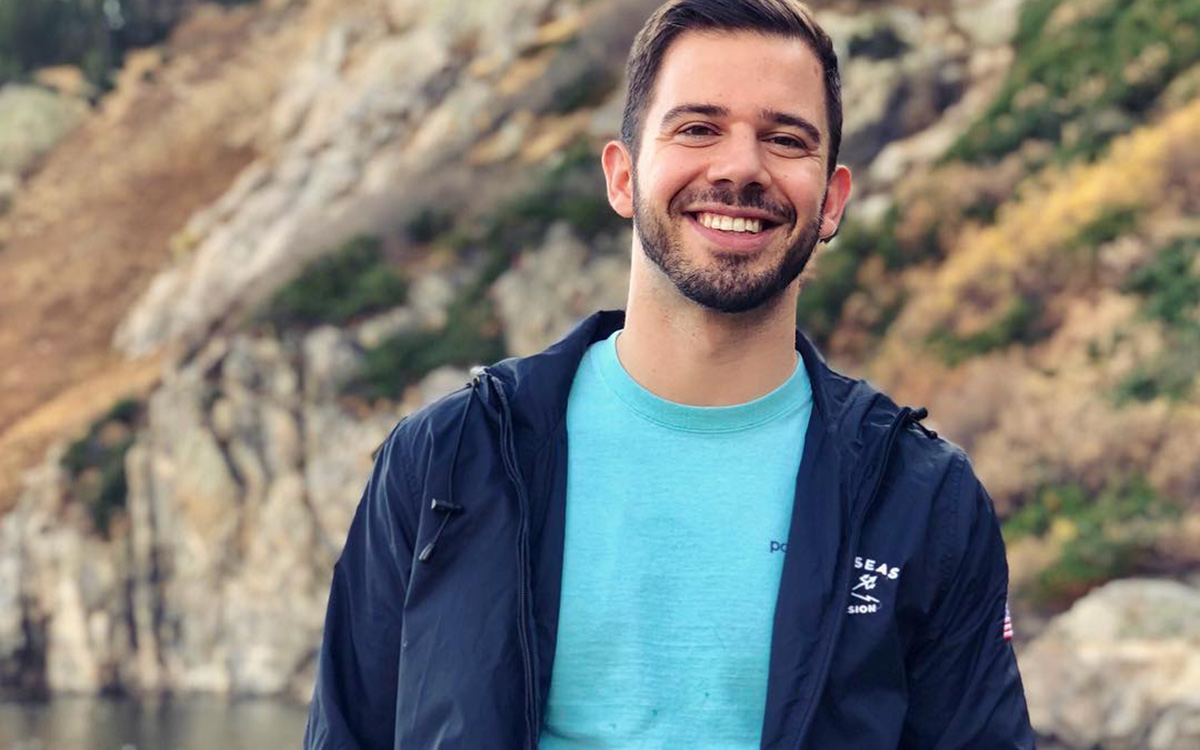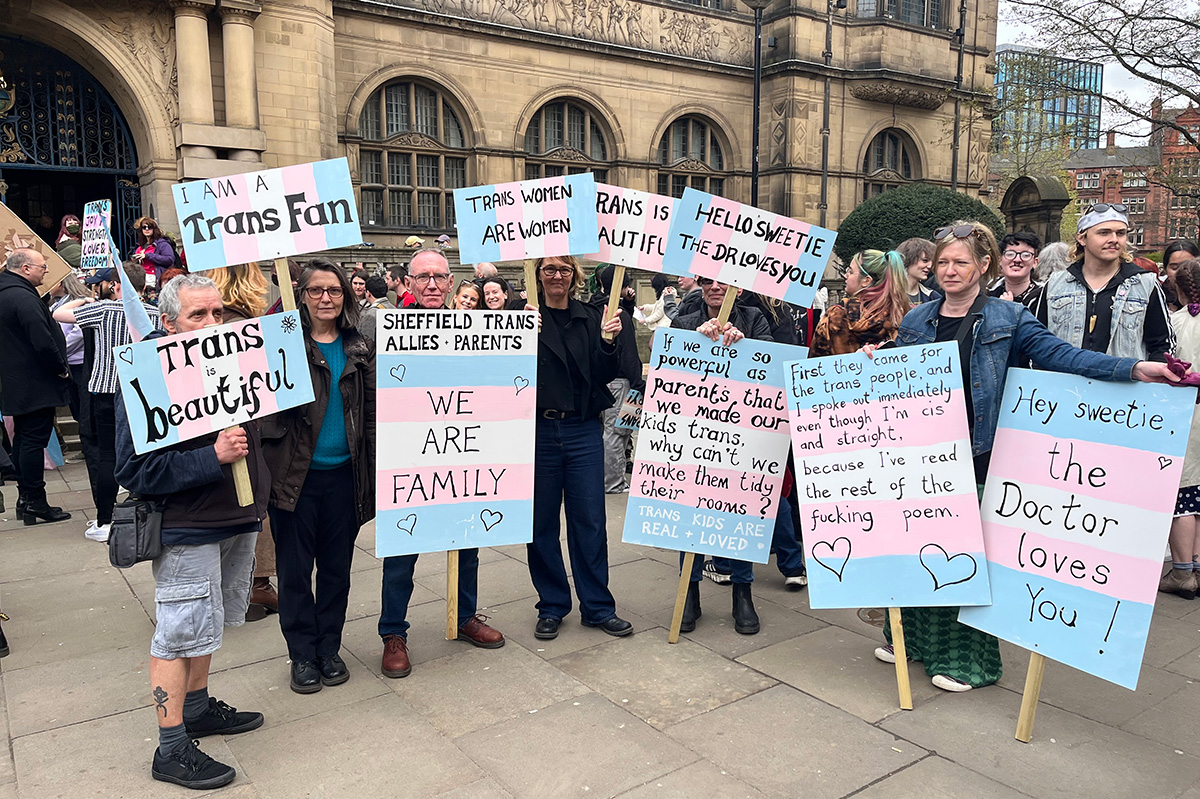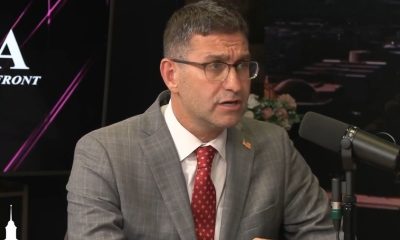Commentary
Survivors of sex crimes are unsung heroes
Taking trauma and turning it to their advantage

(Editor’s note: This is the second of a two-part story. Click here to read the first installment.)
Last month, I started watching “The X-files.”
For the most part I loved the show, with Agents Scully and Mulder as the primary reasons why. Yet what I found most frustrating was watching their investigations. As early as episode one, set in a small town of scared people guarded by scary men, Agent Scully proposed coincidences while Agent Mulder proposed aliens. Despite the episode having “cult” written all over it, both agents seemed none the wiser.
Recently, I learned the FBI has an open process for writers and other creatives to learn how the agency works. I also discovered the FBI has a history of monitoring writers. In fact, the FBI is about as image-conscious as your typical D.C. gay, making me wonder how the “X-Files” moved forward with little pushback. That’s about as interesting as UFOs being discovered in New Mexico as we tested the atomic bomb.
But if you’re reading this, you likely want me to shut up about the “X-Files” and get back to my story. When I left off, my friend had disappeared and my work cleared me of any wrongdoing. That said, I was mysteriously fired in September 2022—nearly a year after the initial incident—and just six weeks after my boss learned that I wrote books.
The process of my firing was strange, to say the least. First and foremost, I was never given a reason. To this day it remains a mystery. My now-former employer—a high-profile lobbying firm—then bullied me into signing an NDA to access my severance.
By the way, I negotiated up. While I don’t know what I did, I had a feeling I had that power. I was right.
Just prior to the firing, they asked me to bring in my laptop so they could download my files. This rang an alarm for me, primarily because they never gave me a laptop. So, they wanted me to bring in my personal laptop. As a writer with original materials, I reasonably asked what constituted a work file. I never received an answer.
Coincidentally, I met my ex-boyfriend exactly one week before I got fired. He is the same ex-boyfriend from my religion piece, in which I mentioned he fell into hard times. Specifically, I was referring to concerning signs I spotted last April, primarily on the gay apps, and with memories of the last boy still fresh on my mind, I refused to let another slip from my grasp.
So, what did I do? I dove headfirst into hell in a messy attempt to rescue him. After playing this new game of cat-and-mouse in which I was said mouse, allow me to share what I learned: Over the course of several months, I spotted sketchy characters at my ex’s place—characters I suspected dealt hard drugs, which was highly out of character for him. Moreover, I found online accounts promoting extremely suspect pornography and, yes, pimping services on X (formerly Twitter), some of which looked a lot like my ex. While I didn’t know what exactly was happening, I knew something was off, but when I confronted my ex, he denied it.
Being the stubborn asshole that I am, I decided to check these sketchy characters out for myself. It turns out I was spot on about their sketchiness. I learned they not only drug unsuspecting young men in a coordinated manner, but once drugged they sexually violate them and—if drugged enough—begin recording videos. It’s all made to look random yet safe; for example, there always seems to be a nurse in the group who is “experienced” in administering needles.
Once I had proof these people were unsafe, I took further action for my ex. In mid-November, I reached out to someone in his personal life, which was a tough decision since he was closeted. I was strategic and chose someone who knew he was bisexual, and after connecting with her on Instagram, spoke on the phone with her the next morning. Upon hearing my concerns, she agreed based on her own observations.
Apparently, she spotted signs of him being physically harmed over the summer. She and I spoke for hours on end about the situation and how we could help him. Then, just a week later, I lost contact with her and my ex. I haven’t heard from either since.
I eventually grew concerned enough to contact the police and the FBI. In the meantime, particularly following my trauma article, sex workers approached me to share their stories—primarily stories of rape and abuse alongside a power structure rooted in it. As for those who try to oppose this system? They’re often written off as mentally ill.
I don’t know about you, but I refuse to live in a world where young queers are shepherded into this system. That’s the opposite of what I envision for the queer community.
Mid-Atlantic Leather weekend arrived in January, along with more sex workers. Once again, some approached me to share their stories—about their aspirations, about their art, about their perspectives on the world. And once again, about the system of abuse designed against them from the start. I heard stories of young boys raped by their fathers, or friends of their fathers, or about the drugs used to coerce them into sexual activity. Sadly, just like a UFO witness, they are usually written off and never taken seriously, especially if they have a record of drug abuse or mental illness. Seems to be a pattern, doesn’t it?
That said, these men are not solely victims. If anything, they took their trauma and turned it to their advantage. I’d like to take this moment to thank them. They’re unsung heroes—each and every one—in a nation that often shames them.
Yet as proud as I am of these sex workers, my heart was equally broken. These stories were painful to hear, to say the least. I quickly grew paranoid of people around me, even friends at times. There were other times I sat alone in my apartment, bawling over the men I had lost, along with the pain others had experienced. This only strengthened my resolve to end it.
To top this all off, my final discovery came just two months ago. Turns out there’s an X account publicly teasing me about this entire affair. The account even references this column and, according to the receipts, started well before I noticed concerning signs about my ex in the first place.
Hello there, dear X account. It appears you’ve been observing me. Consider this my proverbial tapping back on the glass.
Wow—there seems to be a lot of time, energy, and effort spent on little ole me. Why is that, I wonder? I’ve mentioned before I’m just a measly little barback who has been fired twice. Although looking back, those firings were strange too, weren’t they?
Is it the abuse I uncovered? Is it the details of my lover’s past? Is it something I wrote? Is it a combination of the three? And is it possible that the little dark cloud that’s been following me in D.C. is more intentional than I once thought?
I may never learn the truth on my own, but I can pose another question: what’s the only thing scarier than UFOs? To me there’s just one answer: that UFOs were never real in the first place. Occasionally, answers to unsettling mysteries simply unearth more unsettling mysteries.
I mentioned before in this column that I arrived to D.C. naïve about the world, perhaps just as naïve as Agents Scully and Mulder. Yet in my naiveté I tripped on something: the rot hiding beneath the surface of our nation’s capital. No, it isn’t coincidence. It isn’t aliens, either. But whatever it is, I alone cannot identify it.
Throughout my time uncovering this story, I’ve come across friends, acquaintances, and even relatives who suffered abuse, along with threats or shaming to keep them quiet. They come from all races, creeds, backgrounds, and orientations, and as it turns out, some of the infrastructure of power in D.C. and in towns across this nation are built around it. While I’m ready to tear it down, this isn’t just my story. I might be the one starting it, but it’s not on me to finish.
The most I can do is hand the pen over to the victims. I’ve shared my part. Now it’s their turn. As for the audience: I hope you’re now ready to start believing.
Jake Stewart is a D.C.-based writer and barback.
Commentary
‘A New Alliance for a New Millenium, 2003-2020’
Revisiting the history of gay Pride in Washington

In conjunction with WorldPride 2025, the Rainbow History Project is creating an exhibit on the evolution of Pride: “Pickets, Protests, and Parades: The History of Gay Pride in Washington.” It will be on Freedom Plaza from May 17-July 7. This is the ninth in a series of 10 articles that share the research themes and invite public participation. In “A New Alliance for a New Millenium” we discuss how Whitman-Walker’s stewardship of Pride led to the creation of the Capital Pride Alliance and how the 1960s demands of the Mattachine Society of Washington were seen as major victories under the Obama administration.
This section of the exhibit explores how the Whitman-Walker Clinic, a cornerstone of the community since the 1970s, stepped up to rescue Pride from a serious financial crisis. The Clinic not only stabilized Pride but also helped it expand, guiding the festival through its 30th anniversary and cementing its role as a unifying force for the city’s LGBTQ population. As Whitman-Walker shifted its focus to primary healthcare, rebranding as Whitman-Walker Health, a new era began with the formation of the Capital Pride Alliance (CPA). Born from the volunteers and community partners who had kept Pride going, CPA took the reins and transformed Capital Pride into one of the largest free LGBTQ festivals in the country. Under CPA’s stewardship, the festival grew to attract hundreds of thousands, with multi-day celebrations, headline performers, and a vibrant parade.
This period saw Pride become a true cross-section of the community, as former Capital Pride Alliance executive director Dyana Mason recalled: “It was wonderfully diverse and had a true cross section of our community… Everybody was there and just being themselves.” The festival’s expansion created space for more people to find a sense of belonging and affirmation. This growth was made possible through the support of sponsors, volunteers, and a city eager to celebrate-but it also sparked ongoing debates about the role of corporate funding and the meaning of Pride in a changing world.
National politics are woven throughout this era. In a powerful moment of recognition, Frank Kameny — the architect of D.C.’s first White House picket for gay rights and a founder of the Mattachine Society — was invited to the White House in 2009. There, President Obama and the U.S. government formally apologized for Kameny’s firing from federal service in 1957, a symbolic act that echoed the earliest demands of DC’s own Mattachine Society, the city’s first gay civil rights organization founded in 1961. The 2009 National Equality March revived the spirit of earlier mass mobilizations, linking LGBTQ rights to broader movements for social justice. The 2010s brought landmark victories: “Don’t Ask, Don’t Tell” was repealed, marriage equality became law. These wins suggested decades of protest had borne fruit, yet new generations continued to debate the meaning of true liberation and inclusion.
Our exhibit examines how the political edge of Pride has softened as the event has grown. As the festival expanded in scale and visibility, the focus on protest and activism has sometimes faded into the background, even as new challenges and divisions have emerged. Some voices have called for a return to Pride’s more radical roots. The 2017 Equality March for Unity and Pride drew 80,000 people to D.C., centering intersectional struggles — police violence, immigrant rights, trans inclusion — and exposing the widening rift between mainstream LGBTQ progress and the lived realities of the most vulnerable. The question remains: Are LGBTQ officers marching in uniform a sign of progress or a painful reminder of Pride’s roots in resistance to state violence? During Capital Pride 2017, activists blocked the parade, targeting floats sponsored by corporations linked to weapons manufacturing, pipeline financing, and other forms of oppression.
As we prepare for WorldPride and the anniversaries of D.C.’s first Gay Pride Day Block Party and the White House picket, the Rainbow History Project invites you to experience this living history at Freedom Plaza. Through archival images and the voices of organizers and participants, you’ll discover how Pride in DC has been shaped by resilience, reinvention, and the ongoing struggle to ensure every voice is heard.
Zoey O’Donnell is a member of the Rainbow History Project. Vincent Slatt is RHP’s senior curator.
Commentary
A conversation about queers and class
As a barback, I see our community’s elitism up close

In the bar, on the way to its now-Instafamous bathrooms, there’s a sign that reads, “queer & trans liberation means economic justice for all.”
I remember seeing that sign the first week the bar opened, and ever since I often find myself reflecting on that message. I stand fully in agreement. That’s why laws protecting queers in the workplace are essential, for far too often we are targeted otherwise. It’s also why I love working at the bar, since it provides opportunities for queers from all over the spectrum to earn a living. At a time when I gave myself space to pursue art, it was the bar that enabled me to do so.
It’s one thing to support the LGBTQ community in spirit, but that spirit means jack in a capitalist society if viable economic opportunities don’t exist. Speaking of jack, there’s a fellow barback named Jack who I fangirl over often. Jack is a decade younger than me, but damn I wish I had his sex appeal at his age (or any age, for that matter). He also has a mustache that easily puts mine to shame.
Jack not only agrees but took things one step further. “Economic inequality IS a queer issue,” he told me, “especially as we move into the most uncertain period of American politics I have ever lived through, it is apparent our identity is now a fireable offense.”
Uncertain is right. We’re fresh off the heels of a trade bonanza, one caused for literally no reason by our current commander in chief. Yet there emerged a strange division when discussing the trade war’s “unintended” consequences. For working class comrades like Jack and myself, we’re stressed about increasing prices in an already tough economy. But the wealthier echelons of our country had something else on their mind: the spiraling stock market. This alone highlights the story of our economic divide, where the same event produces two separate concerns for two distinct classes.
This is not to say the stock market is not important, but sometimes the media forget many Americans don’t own stock at all, including a vast majority of people between 18 and 29. In fact, according to Axios, the wealthiest 10 percent of Americans own 93 percent of the entire stock market, with the richest 1 percent holding $25 trillion — that’s right, trillion with a “t” — in market value. So, when the president reversed course on trade, it was less about high prices hurting everyday Americans and more about the dent created in the wealth of the wealthiest. And I’ll admit: that bothers me a lot.
If there is any takeaway from Trump’s trade war, it should be this: Economic inequality is the highest it has been in decades and, if left unchecked, will destroy the fabric of our country. We are steadily moving toward oligarchy status—if we’re not there already, that is—and it seems to grow worse with each passing year and administration. But in a city of D.C. gays who often skew corporate, I wonder: Are we all on the same page here?
After becoming a barback, I have my doubts. From questions about what else I do, to comments encouraging me to work hard so that I can be a bartender one day, I quickly learned the gay world is not too fond of barbacking. Barebacking, sure, but not barbacking. And hey, I get it—we’re not the alcohol hookup at the bar. Still, we are part of the service industry, and while some people are incredibly kind, you’d be surprised at how many turn up their noses at us, too.
Recently, I’ve come to realize my class defines me as much as my orientation does, if not more. Naturally, when you come from a rough neck of the woods like I do, it’s easy to feel out of place in a flashy city like D.C., which Jack noticed, too. “Anyone from a working class background could testify to that,” he said. “I don’t really know anyone from true upper class backgrounds, but I’d imagine their experience is one that leans into assimilation.”
Assimilation is a key word here, for admittedly gays love to play with the elite. Often, we don’t have children, meaning more money for the finer things in life, but that also means we may not think about future generations much, either. I’ve written before that our insecurity growing up has us ready to show the world just how powerful gays can be—power that comes in trips to Coachella and Puerto Vallarta, or basking in the lavish houses and toys we own. There’s already a joke that gays run the government, and corporate gays kick ass at their jobs as well. So, given the choice between fighting inequality and keeping a high-paying job, I must admit I have a hard time seeing where D.C. gays stand.
Admittedly, it worked out in our favor before, given that many corporations catered to our economic prowess over the years. But look at what’s happening now: Many corporations have kicked us to the curb. Protections are being stripped from queers, particularly for our trans brothers and sisters. Law firms are bowing down to Trump, offering hundreds of millions in legal fees just for their bottom line. All of this will hurt both queers and the working class in the long run, so again I ask: Corporate gays, where do you stand? Because if you remain complicit, that’s bad news for us all.
I don’t want to sound accusatory, and I hate being a doomsday type, so allow me to end this on a better note. Strength is not about celebrating when times are good. Arguably, true strength emerges when times get tough. These are tough times, my friends, but that also makes now the perfect opportunity to show the world just how strong we are.
At a time when the world is pressuring us to turn our backs on each other, we must defy them to show up when it counts. Corporate gays—now more than ever, at a time when the economy is turning its back on queers, we need you. We need you to stand up for the queer community. We need you to make sure no one gets left behind. We need you to show up for us, so that we can show up for you, too.
Ten years ago, the economy didn’t turn queer out of nowhere. The economy turned queer because we made it turn queer.
And if we did it once, surely we can do it again.
Jake Stewart is a D.C.-based writer and barback.
Commentary
Fight against TERFs goes global
UK Supreme Court on April 17 ruled legal definition of ‘woman’ limited to ‘biological sex’

After last week’s U.K. Supreme Court ruling that reduced the legal definition of “woman” to “biological sex,” footage of a group of women celebrating the decision with champagne spread virally across the media. These women are known as trans-exclusionary radical feminists, or TERFs.
In response, thousands of transgender people and their allies — including parents, siblings, and pro-trans celebrities — flooded the streets of London, Sheffield, Manchester, Cardiff, and other cities across the U.K. on April 19, to protest the erosion of trans rights. The fight between TERFs and trans* people have become more visible to those outside of the British LGBTQ+ community.
But this isn’t just about the U.K. The problem has gone global. For me, as an openly trans person who has lived in four different countries, it feels deeply personal.
For years, British TERFs have been spreading misinformation about gender around the globe, collaborating with far-right politicians and inspiring anti-trans violence.
At a pro-trans protest I attended in Sheffield, one of the speakers, Sofia Alatorre, a trans woman from Mexico now living in the U.K., dedicated her speech to the ways British TERFs, with their powerful movement supported by celebrities, such as “Harry Potter” author JK Rowling, are influencing people in South America.
“When I go to Mexico now, I don’t just hear people talking about transsexuals as degenerates anymore. Instead I hear about what bathroom we should use, or whether we belong in sports,” Sofia told the Washington Blade. “These are not lines that come from Mexico. They are finely crafted narratives designed to drive a wedge by weaponizing ‘common sense’ gut reactions to complicated subjects. Because without these, they’d have to face the uncomplicated reality: We are just people trying to live our lives happily. In the U.K., the entire media infrastructure is sympathetic with ‘gender critical’ TERF ideology to the point that sympathy blurs into outright support. With these lines finding footing in the Global South, it seems clear that the U.K. has become an exporter of transphobia.”
Unfortunately, TERFs even showed up at a trans event, attempting to argue with the speakers.
One of the trans* organizers of the Sheffield demonstration, who preferred to remain anonymous, expressed their love for the trans* community and trans* people. They emphasized that they are not expressing hatred toward TERFs — they simply want them to reconsider their position.
“If you’re a TERF and reading this, we don’t hate you,” they said. “We don’t hate you. There is nothing I hold in my heart but deep pity for you. You do not know the community of love that we have as transsexuals, and you only know your community of hatred. If you are tired of feeling nothing but hate, come and talk to us, we’re nice, I promise. This protest is a rallying cry that we can’t lose, that we are all here for each other, and that we can do whatever the f*ck we want when we work together. We may be out here today in rage, but what keeps us alive is love.”
But it doesn’t seem like TERFs are ready to show love toward trans people — or to see trans women as their sisters. At our local protest in Sheffield, they were so agitated, jumping toward speakers and trying to engage with them, that the police had to intervene and remove them to prevent a fight. It reminded me of TERFs’ behavior I encountered in St. Petersburg, Russia, and in Russian-language online spaces.
Unfortunately, it’s not just South America that has been influenced by UK TERFs. The country I currently live in is known within European and U.S. queer communities as “TERF Island.”
Some trans Americans even avoid traveling to the U.K., afraid of the influence that Rowling holds over millions due to her wealth and cultural impact.
In Russia, Ukraine, and other Eastern European countries, so-called “radical feminism” is the most prominent feminist movement. Radical feminism, which emerged in the 1960s, is based on the belief that patriarchy is the root of all other forms of oppression.
In modern Eastern Europe, this has led to a situation where many feminists fail to acknowledge racism, ableism, and transphobia — excluding everyone except cisgender people, Slavic, atheist, and able-bodied people from their movement. Historically, radical feminists have not focused much on the trans* community, but with the rise of trans* activism in the 2000s, many became fixated on targeting trans people.
Many of my Russian-speaking trans friends have been badly bullied by local TERFs. Some even experienced suicidal thoughts and severe anxiety due to online harassment from them. And these TERFs weren’t developing their ideology locally — they were importing it. The anti-man rhetoric was inherited from American prominent radical feminists like Andrea Dworkin and Ti-Grace Atkinson, while the transphobic elements were “exported” to Eastern Europe, primarily from the U.K. and specifically Scotland.
Even before Rowling, there was Magdalen Berns, a Scottish TERF YouTuber who was extremely popular among Russian girls and women. It was Berns who helped bring Rowling into anti-trans activism.
I spoke with Sophie Molly, a Scottish trans activist and politician who ran as an Independent MP candidate in the 2024 U.K. general election for the Aberdeen South constituency.
TERFs ruthlessly harassed her during her campaign.
“Transphobia is institutionalized in the UK. It is systemic and it’s getting worse with each passing day” she told me. “Local TERF have a slew of legal professionals on their team too. Like Sarah Phillimore and Joanne Cherry. TERFs have been continually lobbying the government to oppress trans and gender non-conforming people. Dragging their rights and freedoms through the courts. All under the pretense of protecting the rights of women. In reality these conservative groups are backed and funded by billionaires. Billionaires that want to remove trans people from public life, due a personal prejudice they hold. The majority of TERFs are wealthy and privileged white women. Most of them are not LGBTQIA+. They have obscene amounts of money to spend on persecuting a tiny minority. Trans women are women — no matter what the U.K. Supreme Court dictates.”
But another problem of TERFs is that they are policing women as well. Even the Supreme Court decision targeted women.
“The [Supreme Court] decision is an attack on the rights of both trans people and women,” Sophie said. “It reduces women to their anatomy, which is extremely regressive and misogynistic in my opinion”
Women for decades have fought to ensure their lives wouldn’t be defined by the sexual organs they were born with. TERFs are now doing exactly that — attempting to reduce womanhood to biology, while also dictating how women should behave, all in the name of “sisterhood.”
Modern British TERFs have received support from figures like musician, far-right influencer, and convicted murderer Varg Vikernes, as well as ultra-conservative organizations such as the Russian Orthodox Church, an institution notorious not only for justifying the war in Ukraine with homophobic rhetoric but also for its long history of opposing women’s rights. This kind of “feminism” is a global threat, not only to trans* people but also to girls and women everywhere.
Editor’s note: The author uses trans* in order to be inclusive of nonbinary and gender queer people.
-

 Congress2 days ago
Congress2 days agoHRC: GOP reconciliation bill would imperil critical LGBTQ-specific programs
-

 Rehoboth Beach2 days ago
Rehoboth Beach2 days agoDel. Gov. Meyer to join Washington Blade party in Rehoboth on Friday
-

 Real Estate4 days ago
Real Estate4 days agoImpact of federal gov’t RIF on D.C.’s rental market
-

 Peru1 day ago
Peru1 day agoPeruvian activists react to Pope Leo XIV’s election












